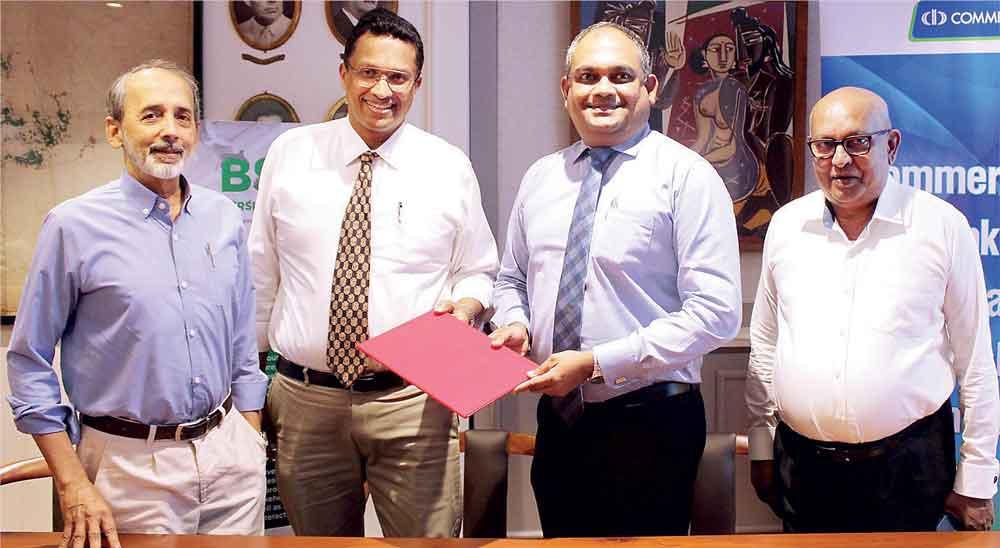Reply To:
Name - Reply Comment

Commercial Bank Deputy General Manager - Retail Banking & Marketing Hasrath Munasinghe with the Chairman of Biodiversity Sri Lanka and Dilmah Ceylon Tea Company Dilhan C. Fernando, the CEO/Director of Biodiversity Sri Lanka and Chairman of DIMO Ranjith Pandithage and Biodiversity Sri Lanka Director Dr. Rohan Pethiyagoda at the signing of the agreement
The Commercial Bank of Ceylon has joined the ‘Life to Our Coral Reefs’ initiative of the Sri Lanka Business and Biodiversity Platform popularly referred to as Biodiversity Sri Lanka (BSL), pledging the full weight of its support to an effort to conserve the Kayankernimarine sanctuary located between Panichankerni and Kalkuda in the Batticaloa District.
The five-year project to be conducted by BSL under the guidance of the Department ofWildlife Conservation in technical partnership with the Blue Resources Trust (BRT), is intended to enhance the resilience of the coral ecosystem,its capacity for renewal, and the provision of ecosystem services, while contributing to the socio-economic wellbeing and development of local communities.
An area of 953 hectares, the Kayankerni Sanctuary was declared under the Fauna and Flora Protection
Ordinance in 2019, but faces significant challenges,both human-made and natural, jeopardising its long-term survival.
According to BSL, export-oriented fisheries focusing on species like groupers, snappers and parrotfish boost the local economy but strain fish populations and fragile coral reefs due to unsustainable fishingmethods, notably bottom-set nets. Illicit fishing practices usingexplosives outside the Marine Protected Area disrupt marineecosystems, while accidental captures of turtles in nets, andnest predation by domestic dogs raise biodiversity concerns.
Additionally, the expansion of aquaculture indirectly affects the marineenvironment with nutrient-rich effluents, and runoff from agriculture in the Maduru Oya basin causes algal growth,disease spread, and coral loss.Natural threats, including annualcoral bleaching events from 2015 to 2019, invasive species likethe Crown of Thorns starfish, and algae proliferation, furtherstrain this ecosystem. A delicate balance between conservation and sustainable practices is crucial to ensuring the Kayankerni Coral Reef’s future and its surrounding habitats.
With the support of Commercial Bank and other corporate entities, the Kayankerni coral reef project will encompass planning and forging community-based connections, preparation for field-based activities, and identifying and establishing partnerships with stakeholders. Activities will be guided by the requirements of IUCN’s Global Nature-based Solutions Standard, and baseline monitoring for the site will be undertaken by the Blue Resources Trustunder the guidance of the Department of Wildlife Conservation (DWC).
This is the second marine habitat conservation partnership between Commercial Bank and Biodiversity Sri Lanka. In 2023, the bank became a corporate partner of BSL’s ‘Life to Our Beaches’ initiative, and undertook to fund the clean-up and continuing upkeep by a beach caretaker family, of a coastal stretch within the Kalutara Beach Park area.
Commercial Bank’s other community projects that promote sustainability include its ‘Trees for Tomorrow’ initiative to plant 100,000 trees around the country, the reforestation of a 100-hectare swath of degraded habitat belonging to the Kandegama forest in the Dimbulagala range of the Polonnaruwa District, a mangrove restoration project in Koggala; a marine turtle conservation initiative in Panama, and numerousstaff engagement initiatives such as beach clean-ups and community projects to uplift the environment.
Biodiversity Sri Lanka is a national platform entirely owned and driven by companies from Sri Lanka’s private sector which have joined, and continue to support the cause of BSL, as its members. The mission of Biodiversity Sri Lanka, which began as the Sri Lanka Business and Biodiversity Platform (SLBBP) in August 2012, is “to mainstream biodiversity into the core business of companies through transformational approaches that involve multiple stakeholder collaborations as well as local, regional, and international interactions.”